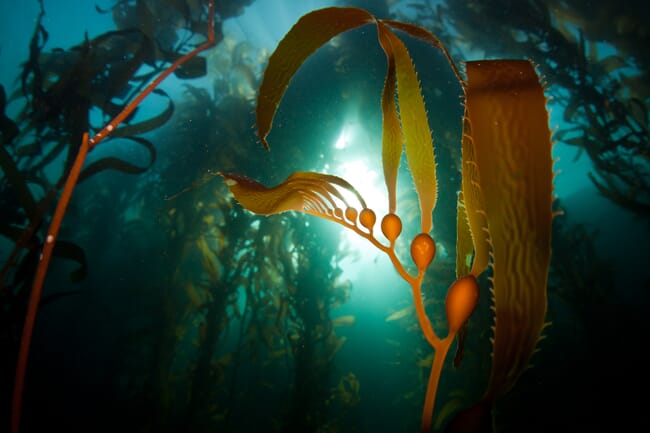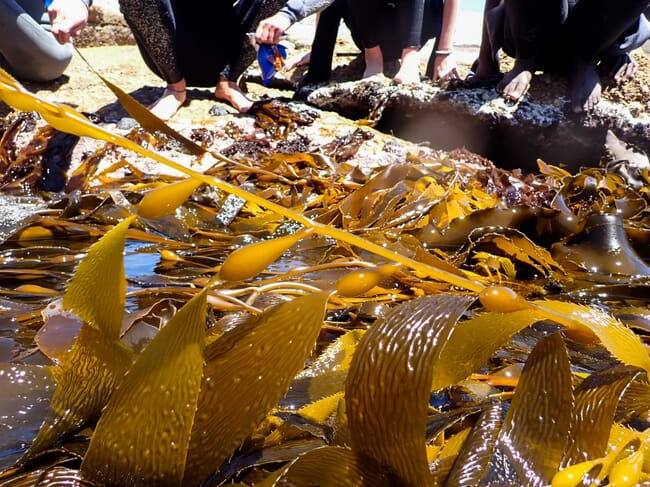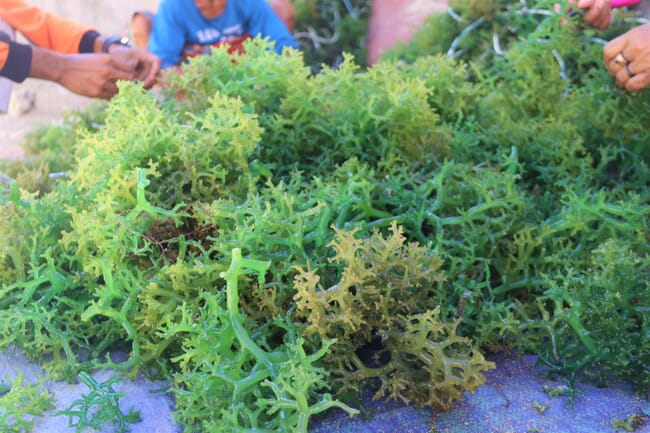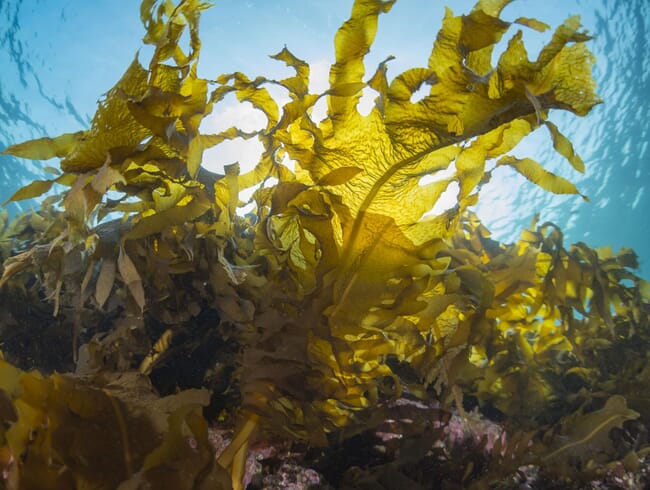
“We have a chance to blow this industry out of the water and put it in its rightful place as a major player in industrial food and other products,” Bill Collins, chairman of Canada’s Cascadia Seaweed told delegates during the World Ocean Summit’s panel discussion on the seaweed industry. However, he was quick to temper some of the hype. “Most of what we do [is] new,” he said – many of the industry’s fundamentals still need to be established.
The talk, which also featured seaweed practitioners like Caroline Slootweg from Kelp Blue, as well as Dodon Yamin from MARI Oceans in Indonesia, highlighted the climate and sustainable development benefits of their businesses. Throughout the discussion, all three ventures were keen to emphasise the growth trajectory and new horizons for seaweed aquaculture – but there was a real sense that many of these benefits weren’t being effectively communicated financial stakeholders and the wider public.
The companies stressed that the industry needs more research and development before it can scale up and deliver on its climate wins. Regardless of the country they operated in, each practitioner noted that key knowledge gaps in farming methods and potential end-uses kept seaweed ventures in the pilot stage. Despite the strong potential on paper and industry hype, the sector’s sustainable growth isn’t guaranteed. The panellists stressed that seaweed stakeholders need to prioritise quality research and communications, lest the industry change from a climate boon to a missed opportunity.

Why the seaweed industry is having a moment
The seaweed sector has been riding a wave of positive media attention for the last three years, with advocates highlighting its status as a climate-friendly source of food and feed for livestock. Emerging research has demonstrated its ability to store and sequester atmospheric carbon – making it a strong candidate for regenerative aquaculture projects. Different seaweed species have a myriad of end-uses as well – from pharmaceutical applications, fertilisers, bioplastics, biofuels and textiles.
Seaweed also stands out as a zero-input food source that doesn’t interfere with land-based agriculture. Seaweed farming requires no fertiliser or freshwater resources and the plants are fast-growing and nutrient intense. According to recent estimates, seaweed delivers $3.5 billion in nutrient biomitigation services each year.
Collins, who has been operating in the space for 40 years, told delegates that seaweed farming sits at a crucial intersection of humanity’s future needs. It performs well as a source of alternative protein and can aid our efforts at ocean decarbonisation. It also can provide livelihoods and stable incomes for coastal communities. However, all three panellists explained that to date, the industry remains largely underexplored and underfinanced. This has limited its ability to jumpstart positive changes in ocean health.

© MMAF
Overcoming knowledge gaps and meeting goals
All three panellists stressed the need for high-quality research and additional investment in areas like farm methods and processing. It seemed like everything from bioactive molecules to carbon sequestration warranted further exploration. For Slootweg, who re-wilds ocean habitat by planting kelp forests, the sector must, “[continue] to invest in the science behind the claims and [continue] to understand what the ecosystem services are.”
Practitioners still don’t know everything that seaweed can do. In Slootweg’s view, our understanding of the production and end-uses for macroalgae are still in their infancy. Red, green and brown seaweeds play specific roles in marine ecosystems and have different carbon sequestration and nutrient filtration abilities. Initial R&D efforts suggest that seaweed will be a source of new ingredients for fertilisers and fuels and provide the molecular building blocks for textiles and plastics.
“There are so many other juicy components in seaweed that still need to be discovered,” Slootweg said. Growers need to continue their investments in research and development to learn what those molecules are and identify new market opportunities.
Collins largely agreed with Slootweg’s assessment, saying that that the benefits of seaweed cultivation need to be paired with science. However, the science and tools that could reward practitioners for their efforts aren’t up to scratch yet.
“The science around carbon sequestration isn’t quite there yet,” Collins explained. “All indications are that seaweed is good at carbon capture, but the extent to which it can capture and permanently sequester carbon is a big question mark.” This knowledge gap must be addressed for the industry to fulfil its growth and climate goals.
For Yamin and MARI Oceans, research and development efforts need to help Indonesia’ seaweed sector become more adaptive. Though Indonesia is the second-largest global producer of seaweed, it significantly lags China’s productive output.

© Minapoli
Yamin explained that in the South Asian context where MARI Oceans operates, creating jobs isn’t enough. He needs to create a business model that will be sustainable in the future. The industry must balance the need for economic and social development with the pressure that farming exerts on ecosystems. Finding solutions and identifying where to make trade-offs can’t be left to research institutions in the US and Europe. Seaweed practitioners need expertise across different countries and farming hubs to jumpstart the sector’s growth trajectory.
Yamin told delegates that the sector must invest in better stemming and aquaculture practices to boost productivity – “we can’t just leave the growth problem to the farmer”, he said. After developing these improved farm systems, the community needs access to better financial options and to establish a presence in the buying segment. This will help the seaweed sector support sustainable economic development by 2030.
Balancing hype and courting finance
All three panellists expressed some wariness over seaweed’s popular hype. It’s true that seaweed practitioners need a bit of buzz as the industry develops, but splashy headlines could lead to inflated expectations from financial investors, policymakers and the wider public. There’s a chance that seaweed firms may not deliver on their targets, leading to a harsh reality check when pilot projects try to scale up.
From Slootweg’s perspective, macroalgae cultivation is new and is still a black box. Potential stakeholders don’t know what seaweed can bring, and a lot of education needs to happen. The hype is helpful, but the problem is that people could expect returns immediately. She also stressed that seaweed forms part of the climate solution. Blue carbon sequestration must be done in conjunction with other climate mitigation strategies to yield the most benefits.
Echoing this perspective, Collins said, “underlying the hype is hope… we need to latch to things and try things that are going to be better for everybody in the future.” However, the hype may present additional challenges when seaweed practitioners are looking for investment or additional financing to scale their operations. Seaweed cultivation can help meet climate challenges and be an avenue for prosperity and wealth generation. “In our business, we include it in the commentary, but it’s challenging to put that as an asset on the balance sheet,” Collins said.
Seaweed aquaculture easily lends itself to many of the valuation metrics found in environmental, social and governance (ESG) investing, but firms often struggle to get that type of recognition when they begin farming – the sector is too new, and many biodiversity benefits are difficult to quantify. “The value that we provide for the planet [is] not yet recognised in that form,” Collins told delegates. “It’s challenging for folks that use traditional [investing] metrics to measure the valuation of the company.”

For Slootweg, a key challenge for the sector is finding the right investor that has a good risk appetite. There are a lot of column inches being spent on impact investors – shareholders who are willing to take on more risks but take on fewer returns – but these lenders can be hard to come by.
When seaweed firms try to scale their operations, the usually ask for larger financial investments. These investments tend to come from loans instead of grants. In many instances, the funds need to be de-risked before firms sign on the dotted line. This can leave seaweed practitioners on the back foot. Seaweed farming is a new frontier – farmers can’t provide the conventional returns or verified assurances to investors.
This dilemma has multiple downstream impacts. Because the capital investment is hard to come by, it becomes more difficult for small operators to scale up. It also makes it more difficult for entrepreneurs to enter the space and spur the innovation that the sector needs.
Yamin has seen this dilemma in Indonesia as well. Since small-scale farmers don’t have financial backing, they sometimes struggle to complete sales or cannot take advantage of product insurance. Lack of financial access has kept ventures small and prevented them from adopting new technologies. These hurdles are precluding the sector from reaching its full potential.

© Asdar Marsuki
Collins stressed that the industry in North America needs to establish returns and assets that investors can understand. Though the benefits of bioremediation and habitat restoration can be nebulous, they need to be defined. Once they are, then seaweed practitioners can work strategically with investors. “This is a viable business that will be good for the planet, but we need some fundamentals to be satisfied in the next five to ten years to make that work,” Collins said.
With the proper research and financial footing, the seaweed sector has a chance to develop more strategically – in line with the UN Sustainable Development Goals and tailoring their innovations with local, provincial and federal laws. Taking this opportunity will allow the industry to develop in harmony with the ocean and coastal ecosystems. It could be a win-win for entrepreneurs and the planet.
Though this presents a complex picture for the industry, the practitioners stressed that seaweed farming presents a workable solution for coastal development, alternative protein sources and climate mitigation. For Collins, who reiterated that seaweed businesses should prepare for the 22nd century, “the time is right, and we have to get on with the job.”
The Economist World Ocean Summit was held from 1 to 4 March.




